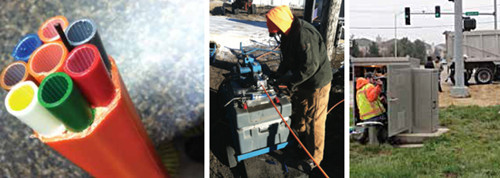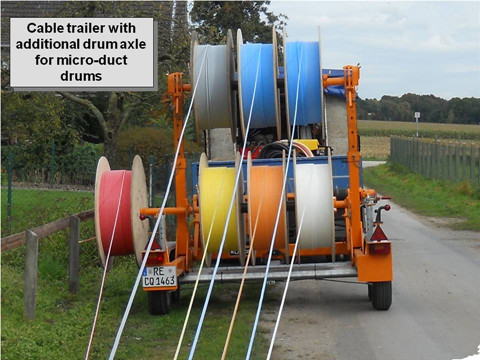When it comes to FTTH deployment, most fiber jumper cables are complicated structures with tight buffered fibers and aramid fiber strength members inside plastic jackets. These cables are adequate for factory termination into prefabricated assemblies, which are not ideal for field termination or fast installation. Therefore network installers are turning to install microduct underground as it can be laid relatively quickly and does not require specialist fiber crews.
Microducts (see in following picture) are typically small-diameter (typically 3 to 16 mm), flexible, or semi-flexible ducts designed to provide clean, continuous, low-friction paths for placing optical cables that have relatively low pulling tension limits. Unlike the conventional optical cables like SC to LC patch cable, microduct allows installation in existing underground duct. Up to four individual microducts can be installed depending on the diameter of the duct and the available space within the duct. Compared to installing larger sub ducts or direct bury fiber, the cost of installing microduct is lower both in terms of material and time. Some tips are provided below to make the direct bury microduct for fiber installation smoother, quicker, and more satisfactory for all involved.

Things You Should Do
- Obtain proper right-of-way permits.
- Identify existing underground utilities, such as buried cables and pipes.
- Investigate the soil condition, in order to determine the installation depth, whether duct should be used, the type of fiber cable that should be used and plowing equipment needed.
- Keep the trenches as straight as possible.
- Always cut the microduct with a manufacturer-approved tube cutter.
- Before installation, make sure that the sealing plug is in place at the ends of the microduct to prevent dirt and water entering the duct.
- Allow plenty of excess pull-cord to exit the duct (3ft or more) - this will be needed when it comes to installing fiber.
- Make sure the draw cord is trapped in place by the sealing plug.
- Do not exceed the maximum pulling force.
- Bury microduct deep enough in the ground to prevent it being damaged by other utilities, rodents, tree roots and freezing ground water.
- Ensure the bottom of the trench is level so that the microduct lies flat; this makes installing the fiber in the duct easier.
- Backfill the trench before installing the microduct to prevent damage by stones.
- Fiber cable warning labels should be buried directly above the cable.
- Backfill above and to the side of the microduct, to prevent damage by stones when you compact the backfill above the microduct.
- When installing an access box, support the microduct to maintain its alignment where it passes through the access box.
Things You shouldn’t Do
- Install with inexperienced personnel.
- Dig where an area is unmapped or unknown.
- Create sharp bends in the duct.
- Leave stones or rocks in the trench.
- Share the space with leaking, unmapped sewage pipes.
- Leave jagged edges on the microduct.
- Do not exceed the maximum pulling tension rating.
- Do not twist the cable - twisting the cable can stress the fibers.
- Do not exceed fiber optic cable minimum bending radius.
- Do not use heavy tools to position the ducts.
- Do not allow the duct to undulate in the trench - apply tension if necessary to straighten routes.
To sum up, the above texts have listed several points that we should look out for when installing microduct. Besides that, you are supposed to follow these best practices to achieve optimum results. The image below shows a cable trailer for microduct transport.

- Calculate if there is sufficient space in the duct.
- Allow an extra length of duct to compensate for the stretching that happens as the microduct is drawn into the duct.
- Allow for expansion of the microduct if air temperatures or storage temperatures are high.
- Allow 24 hours to pass before restraining the microduct to allow it to reach the same temperature as the duct and jointing chamber.
- When using a winch to pull in the microduct, do not exceed the maximum pulling force, by using a mechanical fuse; a fuse is not required if pulling in the microduct by hand.
- Always use a swivel to prevent the microduct twisting as it is pulled into the duct.
- Always use a pulling sock to distribute the pulling force over the first part of the microduct.
Summary
As noted before, microducts are an important part of many fiber deployment as it does not require specialist fiber crews and can be buried quickly. However, cable installation is never an easy thing, adding to time and cost. Thus following the above instructions and using high quality equipment is critical to ensuring successful deployments.
评论
发表评论